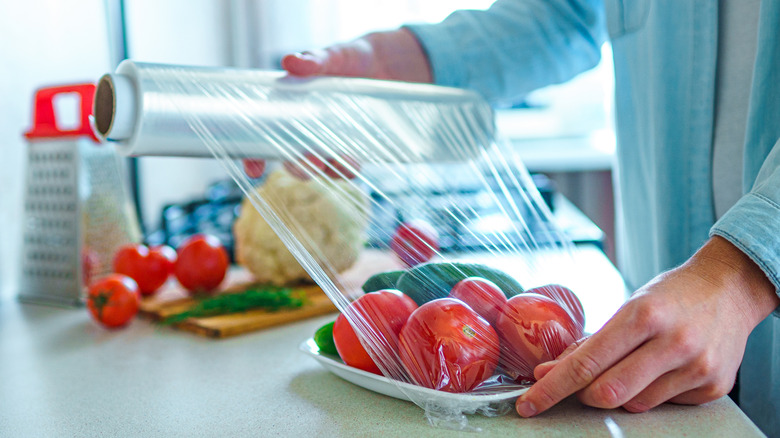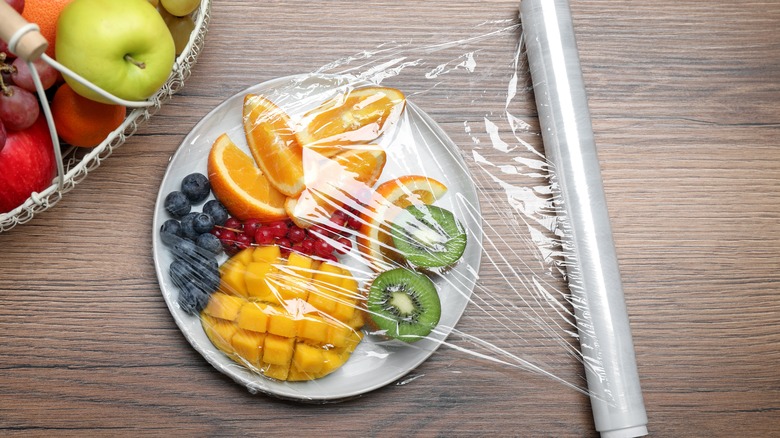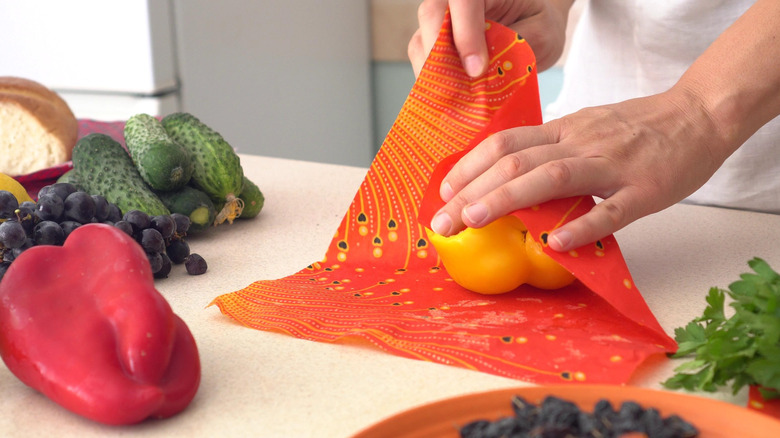Why You Should Stop Using Plastic Wrap Immediately
Plastic wrap, commonly known as Saran wrap, food wrap, or cling film, came into vogue as a kitchen necessity in the 1950s. It was inexpensive, convenient, and practical and seemed to be a step up from cellophane. The wrap was more transparent and pliable, and it preserved food better because air could not penetrate it. As reported by The Washington Post, advertisers pushed it as hygienic and able to thwart bacteria. What could possibly be wrong with it? Well, the environmental threats posed by plastic are now well-known, and plastic food wrap shares some of the blame.
The advocacy organization Beyond Plastics estimates that more than 90% of all plastics in history have not been recycled. As a result, greenhouse gases and toxic chemicals are continually released, polluting the air and our oceans. Plastic micro-particles now permeate drinking water, seafood, honey, and even salt (Almost Zero Waste). Plastic wrap is hazardous in itself, and it contributes to the scourge of plastic pollution. It contains either PVC (polyvinylidene chloride) or low-density polyethylene, neither of which are harmless. It is difficult to recycle and can leach chemicals into your food if microwaved. The plastic film is indeed a household boon, but its negatives cannot be ignored. A tremendous amount is used annually by the food industry and individuals, so much that the entire state of Texas could be shrink-wrapped (Zero Waste Mvmt).
Origins and detriments
Today's commercial plastic wrap was created almost 75 years ago by scientists at Dow Chemical. Fifteen years earlier, its main ingredient was used in spray form to protect planes and military equipment from salt water. According to Curionic, Dow chemist John Reilly coined the name Saran as a nod to his wife and daughter, Sarah and Ann. Originally, it had a green tint and an unpleasant smell.
The PVC in plastic wrap contains toxic elements, including lead and cadmium, as well as a plasticizer known as DEHA. It has been linked to hormone disorders and is a possible carcinogen. Saran wrap is now produced by S.C. Johnson & Son, which has replaced PVC with the more benign PVDC (low-density polyethylene). However, you may have noticed the wrap is not as clingy and is less effective against food spoilage than it once was. And some other manufacturers continue to use PVC in their products.
Recycling the wrap is a problem. Its chemical components resist removal during the recycling process, and the plastic film can foul a facility's sorting lines, per South San Francisco Scavenger Recycling Guide. Its use guarantees it will be soiled by food, rendering it unacceptable for recycling. Note: Some grocers and large retailers will take your plastic wrap if it is cleaned first and dried. Tainted wrap must go into the trash, which then goes into the landfill, where it can take as long as 450 years to degrade (Brightly).
Smart alternatives to plastic wrap
If we do not change our behavior, the UN predicts that in 30 years, there will be less sea life than plastic in the world's oceans (The Earth Site News). Reducing the use of plastic food wrap would help counter this trend, and there are several sensible alternatives.
Beeswax food wraps are an environmentally friendly choice. More practical than their single-use counterpart, they are reusable and can even be washed. Instead of PVC or PVDC, they are composed of organic materials, including cotton, beeswax, resin, and jojoba oil. Even the packaging is biodegradable. They can be frozen and formed into packets, and beeswax becomes more pliant the more you use it. However, the food wraps can melt if used improperly.
Fabric food wraps are an eco-friendly stand-in. Relying more on glass or stainless steel containers also makes sense, or you could use lidded containers or bowl covers made of silicone. Refrigerated food can be covered with a plate instead of cling wrap. Green Matters suggests using oil cloth or glass Mason jars as other substitutes. Parchment paper won't stick, but it can also be used instead of plastic.
The goal is to use less of the problematic plastic wrap. Simply planning ahead so you have fewer leftovers to wrap would be a good start.


